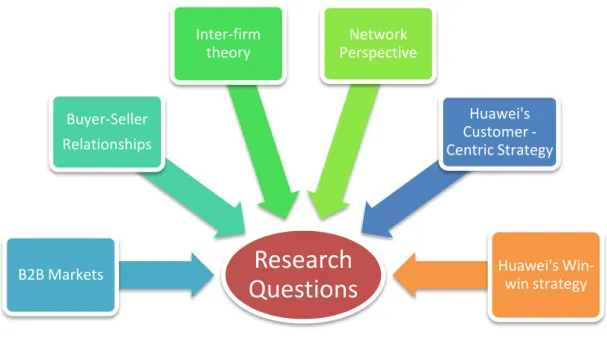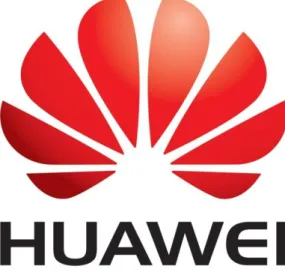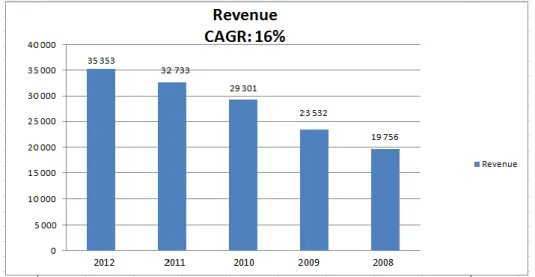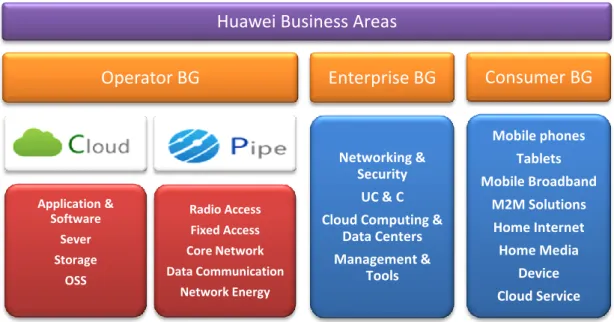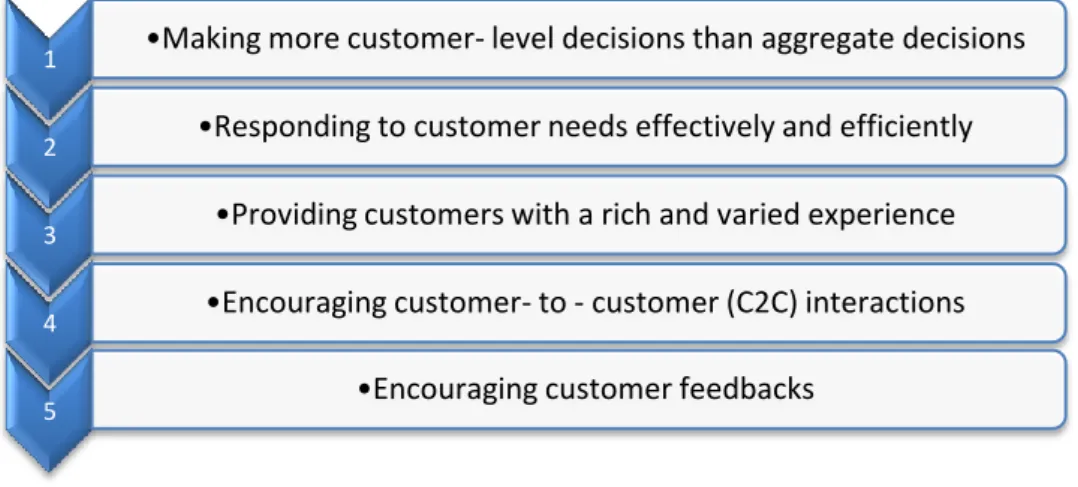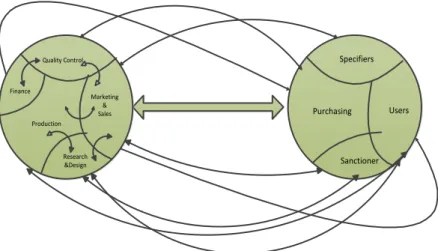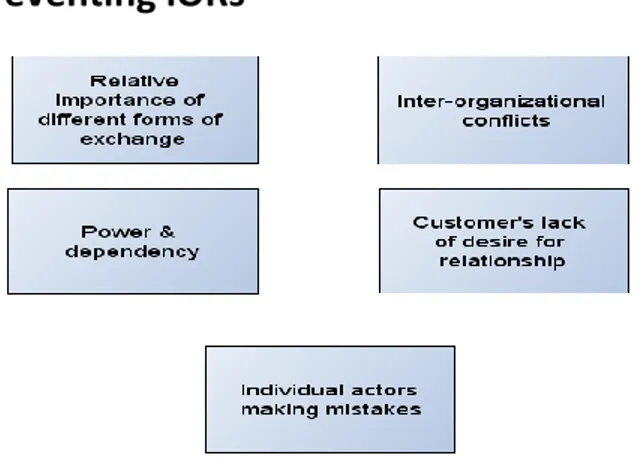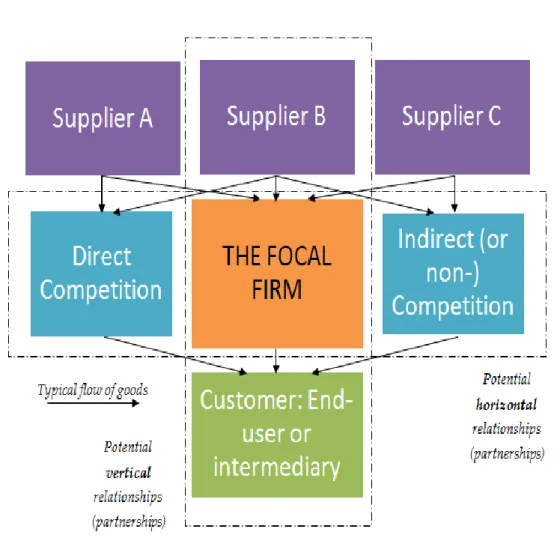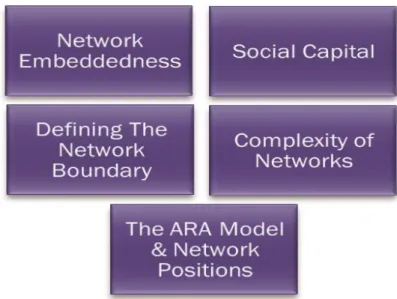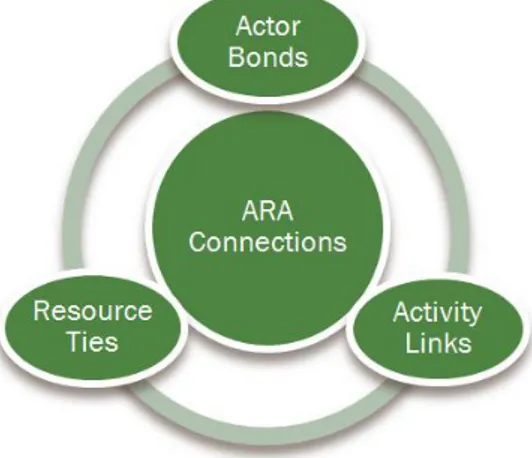BUSINESS
-
TO
-
BUSINESS MARKETING
A NETWORK RELATIONSHIP APPROACH
A case study of ICT solutions firm Huawei Operator BG sales network
A
UTHORSDOAN NGOC THAO NGAN SHANJIAO WANG
FEI KONG
SCHOOL OF BUSINESS,SOCIETY AND ENGINEERING COURSE:BUSINESS ADMINISTRATION BACHELOR THESIS COURSE CODE: FOA214
15ECTS
Tutor: Magnus Linderström Examinator: Eva Maaninen Olsson Date: 2013-01-08
E-post: magnus.linderstrom@mdh.se eva.maaninen-olsson@mdh.se
ABSTRACT
Course FOA 214 - Bachelor Thesis in Business Administration 15 ECTS Institution Mälardalens Högskola
Date January 8th 2014 Authors
Ngan Doan Ngoc Thao - April 7th 1989 Shanjiao Wang – March 13th 1990 Fei Kong - October 30th 1989 Examiner Eva Maaninen Olsson Supervisor Magnus Linderström
Title B2B Marketing – A Network Relationship Approach: A case study of ICT solutions company Huawei Operator BG sales network
Keywords B2B Marketing, Interaction, Inter-organizations, Buyer-Seller Relationships, Network, Sales Network, i.e.
Research questions
1. How do parties considered in the sales network of Huawei Operator BG influence the interactions and business activities of the company?
2. What factors have strong effect on Huawei Operator BG sales activities with their customers?
Research Purpose
The purpose of this thesis is (1) to analyze and describe the role of relationships to multinational companies such as Huawei from a network perspective. In particular, the authors aim to (2) understand how Huawei Operator BG sales department think about and manage their supplying and buying partnerships and the interrelation with other parties in a foreign market with respect to designed B2B marketing theories.
Method
This study is qualitative in its nature and is structured as a case study. Both secondary and primary data were used for the case investigation. Primary data were acquired from semi- structured interviews. Secondary data were collected from electronic sources.
Conclusion
By analyzing all the interaction contents above, we have recognized that the business of Huawei Operator business division has been influenced by all participants in their sales network. The analysis chapter of this thesis shows the clear connection between the case of Huawei Operator BG sales network and the B2B marketing theories used. By looking at the interactions and relations between actors in this network, we have seen that the close embeddedness and interdependence between Huawei and their supplying and buying partners are constrained by many drivers such as the competition, technology development, trust and the level of closeness of relationships and the transparency (or the uncertainty) of the industry. The profound investigation into the buyer-seller relationships between Huawei Operator BG and their customers demonstrates not only the significant roles of trust and promises but also gives a close look to how the business relationships actually work in this specific B2B environment.
Working on this Bachelor thesis has been a challenging but interesting task. Given the limited timeframe, without the wonderful support of the people involved, this thesis could not be finished. Thus, we would like to dedicate this accomplishment to those people who have motivated and helped us throughout this difficult process.
First and foremost, we would like to express our deepest gratitude to our supervisor –Professor Magnus Linderström. His guidance and advices during this Bachelor thesis was invaluable not only for our study but also for such a professional working experience.
Moreover, we would like to thank our family and friends who have always supported and encouraged us for the last two months. Without their kind-hearted help and tolerance, we could never reach this achievement.
Thirdly, we appreciate the generous help of the interviewees from Huawei Sweden and Huawei Peru who have given us the beneficial information to our empirical finding. We also would like to thank our Chinese friends who gave us the chances to contact these respondents.
Last but not least, we would like to thank our thesis partners who have always encouraged each other to work and helped each other improve the quality of our work. Despite the conflicts occurring during our time working together, we understand that the aim of those discussions was only to support each other and enhance the quality of this thesis as a whole.
Chapter 1 - Introduction ...1 1.1. Background ...1 1.2. Problem Discussion ...3 1.3. Purpose of research ...5 1.4. Research questions ...5 1.5. Delimitation ...5 1.6. Target group ...6 1.7. Thesis disposition ...6 1.8. Reference system ...7
Chapter 2 - Company presentation ...8
2.1. Historical background of Huawei...8
2.2. Huawei business divisions ... 10
2.3. Win-win strategy ... 11
2.4. Partnership ... 11
Chapter 3 - Definitions ... 13
3.1. Customer- centric organizations ... 13
3.2. Business partnership ... 14
3.3. Win-win situation ... 14
3.4. Boundary roles ... 14
Chapter 4 - Theoretical framework ... 15
4.1. Introduction to B2B Marketing theory ... 15
4.2. Inter-firm theories ... 16
4.2.1. Inter-firm relationships ... 16
4.2.2. Distances between firms ... 17
4.2.3. Factors preventing IORs ... 18
4.3. Network in a B2B market ... 19
4.3.1. Definition of network in B2B Marketing ... 19
4.3.2. Network characteristics and approaches ... 20
4.3.3. Network management strategy ... 25
4.4. The growth of buyer-seller relationship ... 27
4.4.1. The importance of relationships between buyers and sellers ... 27
4.4.2. Functions of buyer-seller relationships ... 27
4.4.3. Relationship bonds ... 28
4.4.4. Trust in buyer- seller relationships ... 28
4.4.5. Promises in buyer-seller relationships ... 29
Chapter 5 - Methodology ... 31
5.1. Research topic selection ... 31
5.2. Research approach ... 32
5.3. Research design ... 32
5.6.1. Primary data ... 34
5.6.2. Secondary data ... 36
5.7. Validity and Reliability... 37
Chapter 6 - Empirical data findings ... 38
6.1. Inter-firm theories ... 38
6.1.1. Interactions in decision making process ... 38
6.1.2. Overcome Culture, Social, Psychic and Geographic distances ... 39
6.1.3. Factors that prevent IORs ... 40
6.2. Huawei Operator BG Business Network ... 42
6.2.1. Suppliers ... 42
6.2.2. Carrier customers ... 45
6.2.3. Huawei Operator BG Sales force ... 50
6.2.4. Competitors and Opponents ... 52
6.3. The growth of buyer-seller relationship ... 52
6.3.1. The importance of relationships between buyers and sellers ... 52
6.3.2. Relationship bonds ... 54
6.3.3. Trust in buyer- seller relationships ... 54
6.3.4. Promises in buyer-seller relationships ... 55
Chapter 7 - Analysis ... 56
7.1. Inter-firm theories ... 56
7.1.1. Interactions in decision making process ... 56
7.1.2. Overcome Culture, Social, Psychic and Geographic distances ... 57
7.1.3. Factors that prevent IORs ... 58
7.2. Huawei Operator BG Business Network ... 59
7.2.1. Resource ties and activity links – Components of A-R-A model ... 59
7.2.2. Interdependence and Embeddedness ... 59
7.2.3. Network boundaries ... 61
7.2.4. Network position ... 61
7.2.5. Knowledge and Social exchanges ... 62
7.2.6. Time and Space aspects ... 62
7.2.7. Network pictures and Self-expectations ... 63
7.2.8. Social capitals ... 64
7.2.9. Network management strategy ... 65
7.3. The growth of buyer-seller relationship ... 66
7.3.1. Buyer-seller relationships ... 66
7.3.2. Relationship bonds ... 67
7.3.3. Promises in buyer-seller relationships ... 67
7.3.4. Trust in buyer- seller relationships ... 68
Chapter 8 - Conclusion ... 69
8.1. Summary of this thesis ... 69
8.1.1. Inter-organizational theories ... 69
8.2. Suggestions for further research ... 71
References... 72 Appendix ... 81
L
IST OF FIGURES
FIGURE Page
Figure 1.1 – Research question forming process (own creation) 5
Figure 2.1 – Logo of Huawei Corporation (Huawei Corporation, 2013) 8 Figure 2.2 – Huawei five-year financial highlight (Huawei Annual Report, 2013) (own
creation)
9 Figure 2.3 – Huawei's product and solutions lines (own creation) 10 Figure 3.1 – The challenges for interaction orientation (own creation) 13 Figure 4.1 – The interactive interface in Industry market (Turnbull W. P., 1987) 17 Figure 4.2 – Some reasons why IORs may not work (Ellis, 2011) 18 Figure 4.3 – Horizontal and vertical network relationships (Egan, 2001, p. 155) 20 Figure 4.4 – Considerations in B2B Marketing from a Network perspective (Ellis, 2011, p.
136)
22
Figure 4.5 – Elements of ARA Model (own creation) 24
Figure 4.6 – Interaction model (Håkansson H. , An Interaction Approach, 1982, p. 32) 25 Figure 4.7 – Levels of network management (Ellis, 2011, p. 193) 26
Figure 4.8 – Relationship function (own creation) 27
Figure 4.9 – Relationship bonds (own creation) 28
Figure 4.10 – Some main functions of trust in the business relations (own creation) 29 Figure 4.11 – Service Promises and Related Marketing Activities (Grönnros, 1990, p. 243) 29
Figure 5.1 – Research model (own creation) 33
Figure 6.1 – Four relationship classes of Operator BG group (own creation) 41 Figure 6.3 – Relationships bonds in Huawei Operator BG (own creation) 54 Figure 7.2 – Sales Internal Interactions in Huawei Operator BG (own creation) 67 Figure 7.3 – Promises chain amongst Huawei, Operator BG sales force and carrier
customers (own creation)
68
L
IST OF
T
ABLES
TABLE Page
Table 5.2 – Information regarding the interviews 35
Table 6.2 – Some characteristics of different customer relationships in Huawei (own creation)
53-54
CRM Customer Relationship Management
B2B Business- to- business
B2C Business- to- consumer
ROI Return on investment
ICT Information and Communication Technology
IMP Industrial Marketing and Purchasing
Telecom Telecommunication
End-user The organization that would use the productions/ services in production
R&D Research and Development
BG Business Group
CAGR Compound Annual Growth Rate
ARPU Average Revenue per User
IOR Inter-Organizational Relationship
OSS Operations Support System
UC&C Unified Communication and Collaboration
A-R-A Model Actors- Resources- Activities Model
M2M Solutions Machine- to - Machine Solutions
C2C Customer – to – Customer
CFO Chief Financial Officer
1 | P a g e
1. Introduction
Within this chapter, a background of the research problem and a problem discussion are given. The purpose, delimitation, target group, thesis disposition and reference style are included together with the research questions of this study.
1.1.
Background
It has been popularly agreed that the longer a customer stays loyal to a company, the more profitable that customer becomes to that company. According to Kumar (1999), exceptional returns on investments (ROIs) can be naturally achieved by firms retaining long-term client relationships. All actions that improve continuity of customers’ buying activity assume an extremely profitable characteristic. According to Bowman (2012, p. 277), many firms have not put enough effort on keeping their current customers, but instead have considered attracting new customers as their major objective. However, the future sustainable sales stream mainly result from the base of existing customers (Bowman, 2012, p. 277). Due to severe competitions in every market nowadays, it was argued that winning and retaining customers rather than exploiting them for a short-term profit defined the key for survival and the competitiveness of firms (Ellis, 2011, p. 19).
Customer loyalty and retention are vital to any business. Some researchers recently have pointed out in that approximately 50% of customers leave their current suppliers every five years. They also conclude that reaching new customers admittedly can be up to 20 times more expensive than retaining existing customers for any firm (B2B International, 2013).Loyal customers are widely considered a competitive resource that needs serious attention from organizational managers (Naghibi & Sadeghi, 2011, p. 902). Another study from the last decade shows that customer retention plays an important role in customer lifetime value (Gupta & Zeithaml, 2006, p. 782). Good customer retention of the company can both avoid customers from shifting to alternatives and reduce customer acquisition costs. The products or services purchased in a B2B environment are usually of huge economic values and consist of high risk and complexity, compared to those in a B2C environment. Consequently, the cost of switching to another supplier is enormous and complex for both the buyer and the initial seller in such trading activities. In other words, customer retention results in about cost- effectiveness and gains stable profitability for firms in an aggressive economic environment. Customer loyalty and retention can be achieved through strong and long-term relationships between suppliers and buyers (Naghibi & Sadeghi, 2011, p. 902).
Many studies have proposed relationship and network marketing as a competitive advantage for industrial companies. The need of valuable information that supports decision making process from buyers and sellers illustrates the significance of interpersonal communication between both parties (Oliva, 2012, p. 30). A study in the last decade shows that the goal of marketing has shifted due to a need to seek and foster long-term and profitable relationship with targeted customers (Bridgewater & Egan, 2002, p. 6).
2 | P a g e
Buyer- seller relationships in industrial (B2B) markets are commonly long-term and include complex patterns of interactions between firms (Håkansson H. , 1982, p. 25). The complicated interactions, mutual benefits and actor bonds make relationships amongst companies embedded in a network (Hart, 2003). Inside a network, interactions between sellers and buyers are often characterized as institutionalized into a set of roles expected from each individual (Håkansson H. , 1982, p. 26). Supplier- customer interactions may bring up thousands of problems. Nevertheless, they are possibly a source of other thousands of opportunities for each actor in the network (Håkansson & Waluszewski, 2013, p. 441). The various aspects of the exchange episodes in interaction processes between both supplying and buying parties result in adaptations and business effectiveness of both; which therefore stabilize the relationship (Mohamed, 1989, p. 2). Moreover, competitive strength in business-to-business markets is often dependent on the firm’s adaptation to the specific needs of a single customer organization (Turnbull, Brennan, & Wilson, 1967). Efficiency and innovation may result from the interactions that relate to the creation, utilization, adaptation and idea exchange (Håkansson & Waluszewski, 2013, p. 445). The characteristics of each actor, in another hand, strongly influence interaction processes, cooperation and coordination between buyers and sellers (Ellis, Business- to- Business Marketing: Relationships, Networks & Strategies, 2011, p. 126). Such specific characteristics may either improve or prevent the efficiency of any actors in the network.
The stellar growth of economic globalization and technology has led to a complex, dynamic and extremely uncertain business environment (Tåg, 2008). Creating and managing customer relationships from a global view have been great challenges for any local enterprise attempting to spread the business beyond their borders. From a global business point of view, it is essential to refer to distinctive characteristics of networks possessed by different international and industry contexts (Bridgewater & Egan, 2002, p. 33). Such distinctiveness has differentiated the access to local resources in a new market, interdependency, interactions and activities of network actors. Therefore, the cooperation and coordination of counterparts in the network are vital for any business more than ever.
The sales force is considered the face of a firm for its customers since they are the staffs who have most direct contact with their firm’s customers. Sales people are the frontline of a firm and are significant in building and maintaining effective connectivity, communication with business buyers (Lilien & Grewal, 2012, p. 30). They are at the heart of the company’s interactions with buyers and play a key boundary role in the organization in B2B organizations where personal selling is significant driver of the marketing mix (Cespedes, 2012, p. 131). In response to the changes in the market environment, such as increasing customer consolidation, product commoditization and globalization, many companies move their major concentration to the value creator role of B2B salespeople (Bradford & Weitz, 2012, p. 417). Salespersons do not only interact with the customers but also with other internal units of their organizations such as marketing, production, engineering or finance in order to make decisions relating to activities with customers. Many researchers approved a multiple and developing role of sales individuals in the firm’s marketing strategies (Lilien & Grewal, 2012, p. 31).
This research revolved around the case ofmultinational company Huawei, which is acknowledged as a leading global information and communication technology (ICT) solutions provider (Dix, 2012). Two decades ago, Huawei was humble in the global market. Nowadays, the company has been seen as the second largest telecom equipment supplier in the world. The company is listed as one of the
3 | P a g e
prominent technical innovators. Huawei has, in particular, expanded their end-to-end capabilities and strengths to such fields as carrier networks, enterprise, consumer, and cloud computing. Their products and solutions have reached out 140 countries, serving more than one third of the world's population (Huawei, 2013).
The significant advancement of general purpose technologies such as the information, computer and the internet has caused structural changes in the telecommunication and media over the last few decades (Tåg, 2008, p. 5). This factor has been a critical problem for the survival and development of firms in this industry. In the last ten years, the world has witnessed the rises and falls of many enterprises in ICT market. Many giants in the ICT market have suffered the down fluctuation. Nokia used to lead in global market share of handsets few years ago. However, this company lost its ground in the smartphones market to Apple Inc.’s iPhones and Google Inc.’s Android devices (Ando, 2011). Alcatel- Lucent, one of the biggest Telecom equipment manufacturers in the world, planned to reduce around fifteen thousand employees by 2015 in response to their recent financial losses (Thomas, 2013). The never-ending movement of technological development has led to the tough competition and high degree of instability of the market. Accordingly, an urgent need of strategic networking, cooperation and coordination in activities and resources of firms has arisen. For a multinational organization as Huawei, interactions between the company and stakeholders, such as suppliers, buyers and end-users, could be very complicated.
The international variables of languages, culture, economic, attitudes and political differences are obstacles for multinational companies to their relationship establishment with foreign business partners (Turnbull P. W., 1979). Enterprises only can decide their actions based on the knowledge acquired by analyzing and evaluating buyers’ data but not on “suspicions” or “experience” (Urbanskienė, Žostautienė, & Chreptavičienė, 2008, p. 20). In a web of several parties involved, the knowledge of customers are interrelated and collected from several other actors in the market. The ways that knowledge of end-users is transferred through the interactions of participants in an international business network and the effect of interactions on investigating such strategic data are interesting topics. In more particular, it would be interesting to investigate in how Huawei perceives those challenges in their wide network and at the same time reduces threats of aforementioned issues to the business in international markets.
1.2.
Problem Discussion
In general, industrial sales force plays a key role in organizational markets according to the orders’ high values, the more complex product offerings and the limited selection of buyers in B2B environment. Generating sales is the duty of every sales personnel. More importantly, the personal customer relationships of a professional salesman can even give his or her company a chance to approach privileged knowledge, hints of competitor initiatives or possibly sight of tenders by rival suppliers. Considered as the image of a company by its customers, sales force’s knowledge about customers and competitive advantages as well as weakness of the provided products or services is essential to the strategic planning of their firm (Pitt & Nel, 1988). Due to the dramatic growth of B2B markets, salespersons are required to not only perform as a generator of sales and a manager of customers, but also have increasingly important responsibility for the development of
inter-4 | P a g e
organizational relationships (IORs) as a part of the firm’s overall customer relationship management (CRM) (Ellis, 2011, p. 319). In terms of the evolving awareness of long-term customer relationships, recruiting and retaining a professional salesman who can handle such tasks is essential for company in a cruelly competitive B2B market (Ellis, 2011, p. 320). Weitz and Bradford (1999) propose salespeople to be an inimitable source of competitive strength.
Although business effectiveness can come from the relationships nourished by personal selling, it is undeniable that the sales force is the most costly B2B marketing communication section for a company to maintain. The greater the complexity of customers’ demands, the bigger investment of sales people’s time and supporting resources in attempt to secure the sale is required. That big investment leads to the increasing cost for firm in retaining their sales force (Ellis, 2011, p. 319). However, in many cases, the amount of financial resource that a company needs to spend on its sales department may not meet their expected sales targets. The development of media means is also a driver that convinces companies to reconsider about their vehicle of approaching customers since it is evident that the reach and frequency of audience contact through personal selling are lower compared with other media means (Ellis, 2011, p. 321). Recent analysis into the sales effectiveness has indicated that over the past several years, the productivity of a sales force commonly has not satisfied their firm’s executives (Dicks, Tepper, & Montan, 2013). However, many researchers suggest that managers/ executives should bear in mind the tensions that can affect sales people who perform all the time in a tough and competitive environment (Ellis, 2011, p. 323). The strategy of gaining a higher degree of sales force effectiveness hence apparently requires the intensive careful planning and clear guidance given to sales staffs over their limits.
Even though Huawei is one of the forefront technological innovators in ICT solutions market where only few business entities operate, sales activities and approaching new customers are still challenging targets. In such a B2B market as ICT solutions, the number of promising business projects can be great due to many organizations’ urgent need of information and communication technological innovation in order to secure and develop their business. Needless to say, the financial benefits from such sales prospects are notable and lead to tough competitions amongst actors in this market. The truth holds that Huawei has been performing very well in ICT solutions markets and gaining remarkable increasing revenues from international markets over the last few decades. For a multinational firm as Huawei, supplier and customer relationship management is of the leading concerns. Huawei maintains its motto in which customer relationships are vital for technological innovation and more importantly, the survival of the company. Relationships relate to the company’s financial improvement as well as to its capability of technological innovation. The company’s image has been influenced by relationships. This image is perceived by the customers through the company’s product quality and partly but importantly through the communications and interactions between the customers and that company’s sales force. Huawei has big sales forces throughout 140 international markets who are in charge of personal selling activities and contribute much in the growing revenues of the company notwithstanding such continuing those sales teams can be very costly. The relationships between Huawei and its suppliers and other parties are also of the authors’ concerns because in a B2B, the sales of a company do not only depend on the sales team of that company and its buying actors but also on its suppliers and competitors as well as opponents. Hence, the relationship strategy of Huawei with all those parties attracted our interest.
5 | P a g e
1.3.
Purpose of research
Scrutinizing and describing the role of relationships with B2B suppliers and customers to the multinational company Huawei from a network perspective were the scopes of this thesis. The authors aimed to understand the customer relationship and partnership management in a foreign market of global companies with respect to B2B marketing through the case of Huawei. The analysis might be relevant for the future sales and marketing management and decisions regarding strategic partnership network of Huawei.
1.4.
Research questions
The research questions were formed based on the authors’ analysis in B2B relationship marketing field.
Figure 1.1- Research Question Forming Process (own creation)
How do parties considered in the sales network of Huawei Operator BG influence the interactions and business activities of the company?
What factors have strong effect on Huawei Operator BG sales activities with their customers?
1.5.
Delimitations
Within the scope of this thesis, the authors concentrated on the interaction approach to the sales network of a multinational company in ICT solutions industry. Huawei was chosen among other companies due to its extreme success in approaching the international markets and gaining the leading position in the worldwide ICT solutions market in a short period of time.
Research
Questions
B2B Markets Buyer-Seller Relationships Inter-firm theory Network Perspective Huawei's Customer -Centric Strategy Huawei's Win-win strategy6 | P a g e
Huawei has officially three segments of business divisions for operators, enterprises and consumers (terminals). We decided to focus only on the relationships in its Operator business group sales network among others due to our ability to get the empirical data and that the carrier network solutions technology is the most traditional and advanced business type of Huawei.
In the internal web of any organization, the communications with other parties occur to any department in terms of the business decision making process such as financial, technical solutions, supply chain management, logistics and service/ product delivery units. However, the opinions about relationships, network and supply channels by staffs of those different departments significantly vary in terms of those human resources’ specific tasks and duties in the operation of an organization. This aforementioned issue was believed to occur also in Huawei and in particular, Huawei Operator BG management. Nevertheless, in this thesis, the authors only analyzed the sales network from Huawei Operator BG sales unit’s point of view due to our short timeframe and ability to acquire empirical data within the limited time period.
1.6.
Target Group
This thesis did not only consider the case of Huawei as a story of business success but also approached it from a critical point of view. Thus, it can be beneficial to Huawei’s Operator BG management in general and their sales force in particular. Such sales managers and key account managers can use this study as an in-depth investigation; which may help them improve their shortcomings in their customer relationship strategy to strengthen their competitive advantages in the global market. Besides, this thesis can be relevant to researchers who are interested in the interaction approach to B2B Marketing.
1.7.
Thesis Disposition
Chapter 1- Introduction presents a background of the theme studied. The purpose, research questions and delimitations are also included.
Chapter 2- Company Presentation introduces the information of the chosen firm, Huawei. Their R&D unit, business unit, sales and partnerships will be presented.
Chapter 3 – Definitions consists of the introduction to some concepts relevant to this thesis. Chapter 4- Theoretical framework provides the relevant theories, concepts and models used
in analyzing B2B marketing, inter-organizations and the growth of the buyer-seller relationships. Researches that related to the subject of this thesis are also comprised.
Chapter 5- Methodology specifies the procedure of the paper from the beginning. The method and choices of data collection are determined and demonstrated.
7 | P a g e
Chapter 6- Empirical Data consists of the empirical data. The information collected from the interviews and from the secondary data resources are presented.
Chapter 7- Analysis gives out the scrutiny of the study based on the collected data and the theories chosen.
Chapter 8- Conclusion shows results and draws a conclusion from the analysis in order to answer the research questions of this research. A section of suggestions for further research is also comprised.
1.8.
Reference System
The reference system in this report followed APA (American Psychological Association) format. Names of authors and the year of publication release would be mentioned when the information was collected from articles, books, documents and websites. The citations were placed within or after a sentence. The full details of the information sources regarding authors, the year of publication, title, page number, the volume and issue number for any article, the edition and publisher for books were provided in the Reference section. Date of accessing, database name and the URL were stated in case of electronic information. The references were described in alphabetical order of the authors’ name in the Reference list (Ghauri & Grønhaug, 2010, p. 241).
8 | P a g e
2.
Company Presentation
This chapter provides the historical background of the chosen company – Huawei. Brief introductions to their business, Win- Win strategy and the partnership which can be found from electronic sources are accordingly presented.
2.1.
Historical background of Huawei
Chinese multinational company Huawei Technologies Co. Ltd. is an employee-owned private technology company operating in telecommunications equipment, networking and services area. The company has around 150,000 employees and its business has been deployed in 140 countries (Huawei Investment & Hodling Co., Ltd., 2013). The company is curently headquartered in Shenzhen, China. It was established in 1987 in Shenzhen, China by CEO Zhengfei Ren. Mr. Ren was formerly a technologist in Chinese People's Liberation Army and listed as the most secretive businessman in the world by Time Magazine that hardly appeared in public (Schuman, 2013).
Huawei Corporation is perceived as the largest telecommunications equipment maker in the world. It is also known as the world’s second largest telecommunications provider. Recently it obtained the world's third-largest maker of smartphones. Huawei follows the strategy of using the countryside to encircle and capture the cities, and it also has moved forward to win foreign markets. (The Economist Journal, 2012).
The company around the needs by customers continues innovation and opens up the cooperation with partners. Those strategies help Huawei throughout its internationalization process. In the telecommunications network, business network, consumer and cloud computing technological fields, Huawei has constructed end-to-end solutions advantages. Huawei is committed to provide competitive ICT solutions and services to telecom operators, enterprises and consumers, continuously improving customer experience to create maximum value for customers. Huawei’s products and solutions have been used in more than140 countries, serving 45 of the world's 50 largest telecoms operators and over one third of the people in the world (Huawei Corporation, 2013). All exported products of Huawei are high-tech.
Since the beginning, Huawei’s vision was to build innovation capability into the company. That is to say, Huawei's overseas strategy chose the most difficult path- “independent brand export company” since the start. This strategy has helped the operators to improve its earnings (ARPU) and its brand
Figur 2.1 - Logo of Huawei Corporation (Huawei Corporation, 2013)
9 | P a g e
competitiveness. Importantly, it also helps to reduce the total cost of the ownership and achieve business success.
In 1996, Huawei made their first effort in the international market and gave the first batch of staffs to overseas markets. Huawei’s first overseas business was in Hong Kong, which brought back for the company a not very big income but this investment showed the development prospect in international markets. Large-scale investment and arrangement of mass employees only empowered overseas since 2000. The successes in Thailand and Russia these two big markets made Huawei find out that the overseas markets have big potentials (21st Century Economy, 2004). Entering African market in 1998 was an important milestone for Huawei when it pertinently removed the "made in China" image of low cost and low quality (Chang & Cheng, 2009). From the beginning of the 21st century, Huawei has increased its speed of expansion into overseas markets and established its first R&D center in Stockholm, Sweden. Since 2001, Huawei has put a lot of effort on its developing in Europe (Huawei expand in Europe, 2005). Huawei established four first R&D centers in the United States in the first year of the twentieth- first century (Chang & Cheng, 2009).
The recent Five- Year Financial Review (2008-2012) illustrates a tremendous growth in the revenue of Huawei even though the last ten years marks the fluctuation of the telecom industry; which was described through Figure 2.2. According to the graph in Figure 2.2, Huawei increased progressively in Revenue from year 2008 to year 2012; which demonstrates the continuous increases in Huawei sales index in this aforementioned period.
In the forthcoming future, Huawei aims to become the largest telecommunications provider in the world (Jorisch, 2012). The company has been putting generous effort on winning more sales, reaching more customers in European and American continents and intends keep this development strategy for the upcoming years (Bloomberg Journal, 2011).
10 | P a g e
2.2.
Huawei business divisions
Huawei categorizes their customers into 3 main business group (BG), respectively Carriers (Operators), Enterprises and Consumers. Each of these BGs has its specific characteristics; and its particular target customers require specific technical products and services from the company. Figure 2.2 illustrates the business lines of Huawei. Overall, Operator BG is the most traditional business line of Huawei while Enterprise BG has been developed within the last fifteen years and Consumer use is a relatively new market of Huawei (Huawei, 2013).
Figure 2.3 - Huawei lines of products and solutions (own creation)
Source: Huawei website
Operator BG includes Huawei businesses with network carriers. And the products and services that are carried out for this business segments are their traditional high-technological entities. Cloud and Pipe are two advanced network technology areas. Huawei Cloud product and service lines provides the building blocks for the cloud, spanning applications and services, storage and security with the products mentioned in Figure 2.2. Pipe product lines aim to provide end-to-end infrastructure enables operators to build an efficient, profitable, and scalable network for future (Huawei Carrier Products, 2013).
Enterprise BG has wide range of customers, such as firms, hospitals, schools and governments, etc. The business divisions bring about specific solutions to each particular business buyer. Enterprise networking provides secure and efficient data transmission to ensure the smooth operation of an enterprise network. UC& C products relate to high level of information availability and high-speed synchronization, turning an enterprise into a well-coordinated organization. Cloud computing and Data centers help the computer network of a firm become “smarter” and more adaptive. The solutions brought by Management and Tools product lines enhance the central management of the basic network, unified communications, tele-presence meetings, video surveillance devices, and data centers (Huawei Enterprise BG Products, 2013).
Huawei Business Areas
Operator BG
Application & Software Sever Storage OSS Radio Access Fixed Access Core Network Data Communication Network EnergyEnterprise BG
Networking & Security UC & C Cloud Computing &Data Centers Management & Tools
Consumer BG
Mobile phones Tablets Mobile Broadband M2M Solutions Home Internet Home Media Device Cloud Service11 | P a g e
Consumer BG operates in a pure consumer market where Huawei supplies phones, tablets and other digital products for their individual customers (Huawei Corporate Information, 2013).
Huawei’s B2B environments determined are Operator BG and Enterprise BG. But within the scope of this thesis and due to the reasons mentioned both in the Delimitation section 1.5 and in the Methodology chapter, our focus came to Operator BG.
2.3.
Win- Win strategy
Huawei recognizes that all stakeholders in their value chain, including the company, need to share the responsibility of maintaining value chain sustainability. The company proposes that the close cooperation with parties such as suppliers, customers and opponents in the fluctuations is crucial to their competitive edge. Huawei staffs believe that through cooperation, they can achieve win-win outcomes and contribute to sustainable business and social development.
Goals of Huawei win-win strategy are stated clearly by their CEO- Mr. Ren on its official website as follows:
Care for employees and offer varied career paths that help realize their individual value Proactively make social contributions to countries and communities in which Huawei operates Operate with integrity and in compliance with applicable laws and regulations
Focus on managing Huawei’s own risks
Cooperate closely with suppliers and play a leading role in assuring harmonious development across the industry chain.
(Huawei Corporation, 2012). Attempting to achieve these aforementioned goals, Huawei aims to stabilize their position and develop by having the approval and support from all stakeholders and the societies where the company establishes its business (Ren, 2010).
2.4.
Partnerships
Operating in more than a hundred and forty international markets, Huawei does not stand alone in their production. Suppliers and customers are seen as strategic partners for Huawei’s technical innovation and business development planning. Microsoft, Citrix, Intel, IBM, etc. are technical product suppliers of Huawei. The company has established many partnerships which aim to provide comprehensive IT solutions and products, enhance engineering cooperation and building competitive products or encourage cooperation features joint innovation and marketing. Twenty-five joint innovation centers have been set up worldwide by Huawei and their partners in attempt to achieve those mentioned targets. Huawei has early realized the serious obstacles such as changing customer
12 | P a g e
needs, frequent natural disasters, and unsettled political conditions in international markets; supplying partners thus are significant for Huawei’s survival when they jointly ensure flexible and continuous supply of materials and services and enhance the confidence of global customers in Huawei’s product and service delivery capability. Thehigh-quality products and services and more importantly the hard work and collaborative efforts of the supplying partners are conceived as key factors that lead to the success of Huawei in international markets.
International research and development (R&D) centers of Huawei mark the generous contributions by all strategic customers and suppliers. Huawei perceives its strategic buying partners as channels of information for innovation and developing trends.
The company’s global partnership system is established and encouraged in order to match their win-win developing strategy. The partnership system and perception vary by the characteristics and duties of each specific Huawei business group (Huawei Corporation, 2012).
13 | P a g e
3.
Definition
This chapter provides some business concepts that are sufficient to this thesis. Customer- centric organizations, business partnerships, win-win situations and boundary roles are in turn introduced.
3.1.
Customer- centric organizations
According to Venkatesan, Kumar and Reinartz (2012), the type of organizational set-up tends to have a detracting effect when firms want to establish long-term relationships that may create mutual values between parties. The ability to establish and retain strong buyer-seller relationships requires the evaluation regardless of the background of individual technological, organizational or strategic aspects. The forefront firms rather manifest their conventional management commitment, analytical abilities and alignment of employee incentives with customer management targets. Thus there is a persuasive need of marketing thoughts that can encourage other departments; hence all internal sectors of an organization can bear in mind the mission to attract and retain profitable clients effectively (Venkatesan, Kumar, & Reinartz, 2012, p. 326).
Figure 3.1- The challenges for Interaction Orientation (own creation)
Source: Inspired by the information from “Interaction orientation and firm performance” article (Ramani & Kumar,
2008)
Customer-centric approach is proposed to serve a portfolio of buyers and customer relationships which are the basis of this type of business. Customer centricity can be achieved by emphasizing on interactions between the firm and its buying partners, between such buying parties. In another word, this centricity is typically interaction orientation. This interaction orientation leads to the view of customers as both a source of business and a potential business resource for the organization. Hence, the customers in such customer- centric organization are considered as a prospective and sustainable resource which can strengthen the organization’s capability of managing their services, product innovation process due to the evolution of technology (Venkatesan, Kumar, & Reinartz, 2012, p. 326).
1 •Making more customer- level decisions than aggregate decisions 2 •Responding to customer needs effectively and efficiently 3 •Providing customers with a rich and varied experience 4 •Encouraging customer- to - customer (C2C) interactions
14 | P a g e
Introduced by Ramani and Kumar (2008), this sort of orientation can be attained by a number of activities as described in Figure 3.1.
3.2.
Business partnership
The “Business partnership” term interprets the method by which some firms try to gain competitive advantages by developing committed working collaborations. Advantages can be achieved through both partners agreeing to share the benefits of merging complementary resources. Through this cooperating method, firms can decrease the degree of uncertainty that appears during developing channel structures and roles. Cooperation enhances parties to strengthen their market positions while sharing the management of the supply chain (Ellis, 2011, p. 82).
3.3.
Win - Win situation
Win- win situation is commonly defined as a business situation where all business parties involved can obtain generously their desires. The phase is generally utilized by sales people of an organization to persuade their counterparties that their course of actions provides advantages for both participants (Donaldson M. C., 2007).
According to organizational theory, the win- win situation should be focused in a long-term perspective. This situation should be extended to all stakeholders of an organization such as shareholders, employees, suppliers, clients, competitors and society at large. In order to acquire this state, a company should constantly strive to intensify customer value creation by studying their customers’ desires, understanding and enhancing their values, building valuable relationships and frequently communicating with them, involving them in the company’s activities. Maintaining good and fair interaction and relationship with all parties by networking broadly, taking notice of the development of the society and creating mutually beneficial opportunities are crucial to build win-win situations for all participants in the internal business network and the society externally. Growin-wing through partnerships with suppliers and customers results in the sustainable development of a company and turns that company into an international network corporation. Management of those companies aiming at win-win strategy needs to balance organizational purpose or business network purpose with self – interest and individuals in the organization should put the needs of their firm as a whole (de Waal, 2012, p. 20).
3.4.
Boundary roles
Boundary roles demonstrate the job positions where individual staffs ought to involve in direct contact with the public or employees of other organizations (Business Dictionary, 2013).
15 | P a g e
4.
Theoretical framework
In this chapter, an introduction to B2B Marketing theory evolution and the sufficient theories that were applied to analyze the acquired empirical data are introduced. The key concepts are also defined.
4.1.
Introduction to B2B Marketing Theory
Although the study of B2B marketing arose during 1890s, it had been humble for numerous of centuries till business relationships became a serious and critical scientific issue (Sheth, Garnder, & Garret, 1988). Important developments followed by enormous changes have occurred to this field and the momentum of B2B marketing has only been gained in the last thirty years (Hadjikhani & LaPlaca, 2013, p. 298).
Researchers in B2B marketing initially paid attention to transactions of products produced for consumption by other organizations and the items that were utilized in the production process of other firms (Lilien & Grewal, 2012, p. 3). As a consequence, this marketing branch used to be remembered as industrial marketing (Webster, 1992).
Behavioral and social sciences contributions to B2B drove the common perception of B2B marketing from an economic perspective and fruitfully empowered the ability to apply marketing theory to an expanding variety of inter-organizational buying cases since 1980s (Hadjikhani & LaPlaca, 2013, p. 294). Although there have been various schools of thought about B2B marketing, an enormous amount of significant researches by the Industrial Marketing and Purchasing Group (IMP) and other contributors have accumulatively built the foundation for the field over the last three decades (Hunt, 2013, p. 283). The relationship between buyers and sellers in industrial markets, the interaction between individual buying and selling firms, the stability of B2B (industrial) market structures and the views from both the buying and selling sides of relationships are considered “challenges” to mainstream economics and marketing (Håkansson H. , 1982, s. 1). Such “challenges” have been the foundational premises of the IMP theoretical structure (Hunt, 2013, p. 289). Based on such premises, interaction, relationships and networks obtained the major focus of researches carried out by this group (Turnbull, Ford, & Cunningham, 1996, p. 44) (Strömberg & Jain, 2011, p. 11).
Purchasing was perceived as a multi-person activity in a research into the North American and European industrial (B2B) markets in the early 70’s of the 20th century. The reluctance of buyers to change their suppliers was determined as a result of the high stability and durability in long-term buyer- supplier relationships in that early research (Turnbull, Ford, & Cunningham, 1996, p. 44). The threats of resource and market uncertainty were the reasons for the long-term relationship tendency between the buying and supplying parties as well as the risk of changes and inertias in organizational buying behavior (Gadde & Håkansson, 2009, p. 34). During 1970’s, due to many studies conducted in Europe, that a more restricted choice of partners was controlled by a few powerful participants was apparently a consequence of increasing market concentration (Turnbull, Ford, & Cunningham, 1996, p. 44) (Strömberg & Jain, 2011, p. 11). According to numerous of researches, the nature of buyer-
16 | P a g e
seller relationships was admittedly a complex issue and the patterns of buyer- supplier interaction and needed weightier investigations (Johansson & Wootz, 1984).
Since its establishment in the mid 1970s, the IMP group has dedicated to the investigation of the relationship nature between actors in complex markets (Turnbull, Ford, & Cunningham, 1996, p. 45). Interaction perspective was introduced by Håkansson and his colleagues for analyzing B2B relationships instead of the mainstream transaction view (Hadjikhani & LaPlaca, 2013, p. 299). Based on behavioral theory, the interaction approach expresses relationships in terms of long-term ties bounding the actors to each to each other (Hadjikhani & LaPlaca, 2013, p. 299). Many researchers have proposed the network relationship management as a significant competitive advantage (Turnbull, Ford, & Cunningham, 1996, p. 46) (Strömberg & Jain, 2011, p. 11). The structure of a company’s relationship network and interdependence in resources play important roles in interaction processes between actors in a business relationship. These factors decide the network position, ability to adapt to and compete in the growing and fluctuating market of a company (Hadjikhani & LaPlaca, 2013, p. 301).
4.2.
Inter-firm Theory
4.2.1. Inter - firm relationships
“Inter-organizational relationship is an important organizational concept for current researches in industrial marketing and purchasing.” (Turnbull, Metis, & Cheung, 1998). An international business-to-business organization is comprised by a set of complex network; and it is embedded in complex relationships with other organizations inside the network. It is a logical necessity for any business transaction, and as a mediating factor affecting and being affected by business exchange. A focal organization will have a relative number of elements in its set. No matter how many organizations a focal firm interacts, presumably such communications with those organizations has a significant effect on that focal firm’s internal structure and decision making (Evan, 1965).The inter-organizational relationships have five specific features: multi-dimensional, directional, structured, varied and evolutionary (Turnbull W. P., 1987).
Turnbull (1987) outlines a model to show the interaction approach between the buyer and supplier relationship in an organization’s units (depicted in Figure 4.1). The complexity of buying decision units is often reflected within supplier companies whereby a wide number of people are involved at the interface with customers (Turnbull W. P., 1987). Both supplier and customer tend to develop a long-term relationship of an economic and social nature within which interactions take place. The interactions between buyer and seller are not necessary initiated by the seller (Turnbull, Metis, & Cheung, 1998).
17 | P a g e Quality Control Marketing & Sales Research &Design Production Finance Purchasing Specifiers Users Sanctioner
Figure 4.1- The Interactive Interface in Industry Market (Turnbull W. P., 1987)
4.2.2. Distances between firms
“The interaction approach recognized the real complexity of industrial marketing and purchasing and provides a framework of analysis, planning and management control” (Turnbull P. W., 1986). The interaction approach is predominantly relevant in the international environment. As the globalization process, the development of relationships across national interface, cultural distance, social distance, psychic distance and geographic distance need to overcome (Cunningham, Inter-Organisational Personal Contact, 1982). These distances occur when two or more companies have cooperation. However, different company has its own operation way, its own organization and its own environment, these factors caused they will have difficulties when they cooperate. it is because they will interact with each other. It will take time and resources to overcome such things. Only these distances can be overcome, the buyer and the seller will have long-term relationship. It is because these distances hinder the proper functioning of the organization. A lot of business deals are lost as the result of the parties involved do not take time to learn about each other to interact.
Cultural distance is the degree to which cultural norms, world views, attitudes, perceptions and
ideas differ between two companies due to come from different countries.
Social distance illustrates the differences between their ways of working.
Psychic distance represents the perception of self and other operating across international
markets.
Geographic distance is the physical difference between supplier and consumer.
The interaction approach provides a framework for the analysis of investment (in financial and human terms) and adaptations (W.Turnbull, 1987).
18 | P a g e
In relationship marketing, the traditional supplier’s customer orientation can be reversed; the buyer also tries to persuade the supplier to provide exactly what the buyer needs.
4.2.3. Factors preventing IORs
Figure 4.2- Some reasons why IORs may not work (Ellis, 2011)
Distances not overcoming among the cooperate companies or that during the relationship time the interacting parties do not trust each other as before can result in the fact that their relationship do not match what they expected. IORs do not always “work” as what company managers expected, it is because inter-organizations are complex, they can function in unexpected ways in different contexts, and there are always external and internal forces acting.
Ellis (2011) points out some factors that restrain the relationships amongst inter-organizations (described in Figure 4.2) as follows:
Relative importance of the different forms explains the importance of social and economic
exchanges. The importance of economic performance should be noticed, despite the significance of social exchange between most organizations.
Inter-organizational conflicts should be accepted. The commercial world is frequently perceived
as a cruel one, with large firms exerting their power quite legitimately over smaller rivals or suppliers.
Power & dependency: the differences in commercial power and dependency are still central to any
purchasing relationships. These issues will be probably to have a significant effect on the nature and longevity of buyer-supplier interaction. Moreover, there can be a great difference between the rhetoric of cooperation in supply chains expressed by buyers and the reality of commercial exploitation faced by suppliers and the marketing managers who represent them.
Consumer’s lack of desire for relationship: customer firms have several considerations over
establishing closer relationships with their suppliers.
- Fear of dependency happens when supplier may act opportunistically and inflexible to choose alternative suppliers.
- Lack of perceived value in the relationship occurs when customers do not believe that the relationship can create a competitive advantage.
19 | P a g e
supplier do not have the ability to make high-quality products.
- Lack of relational orientation in the buying firm refers to that the buying culture of the firm perhaps stays transactional.
- The pace of technological change happens when committing to one supplier may miss out on innovations through alternative relationships.
Individual actors making mistakes is also a reason can cause damage to a business relationship.
For example, a wrong supply, which is not due to the primary orders, conducted by the logistics department of the suppliers can have huge impact on the production of the buyer.
(Ellis, How IORs may "work" in Different Contexts, 2011)
4.3.
Network in a B2B Market
4.3.1.
Definition of network in B2B marketing
A network can be visualized by using the image of a spider’s web. A focal network is determined as a structure that consists of various different threads interlinking patterns in business environment (Håkansson & Ford, 2002, p. 133). Such patterns are parties such as end-users manufacturers, suppliers of raw materials and components, the companies producing complementary and/or competing products, i.e. substitutes (Håkansson & Mattsson, 1982, s. 5). Each of those active and heterogeneous parties interacts with each other and utilizes their supplier’s products and services to seek solutions to their different problems in production. It is hard to define or delimit the network surrounding a company (Ford D. , Gadde, Håkansson, & Snehota, 2002, p. 1). There is no objective network and a complete description of it. No company is able to entirely control either the process or the results of the relationships which it involves in. Alternatively, through the consecutive results of the interactions directly and indirectly between connected actors and their respective investments and adaptations, each relationship emerges (Payne, Ballantyne, & Chistopher, 2005). Business relationships between each pair of B2B actors link to each other (Ford D. , Gadde, Håkansson, & Snehota, 2002, p. 2). Things that occur in one relationship always affect all connected relationships either marginally or substantially (Håkansson & Ford, 2002, p. 134). The development or termination of any relationship between two parties affect on other relationships.
Figure 4.3 demonstrates the structure of focal network relationships in horizontal and vertical dimensions. Vertical relationships include those that integrate nodes of the supply channel while horizontal dimension consists of the relationships with organizations at the same level (in the network) that look for the collaboration for mutual benefits. Horizontal networks are observed to exist when firms find the solutions to provide for specific customer needs (Ellis, 2011, p. 135).
20 | P a g e
Figure 4.3- Horizontal and vertical network relationships (Egan, 2001, p. 155)
4.3.2.
Network characteristics and approaches
The importance of different network relationship dimensions can be demonstrated in a social context (described in Figure 4.4) in accordance with the structure of focal network relationships (see box 4.3). The embedded and complex characteristics, network boundary, social capital of relationships are considered in the relation with the Actors- Resources- Activities (ARA) Model and the companies’ network positions.
The limited amount of powerful actors in a B2B market was apparent phenomenon. From connecting with each other, these companies in terms of its ability to obtain sustainable resources and position have strong effect on each other; which then results in a net of complex interactions, adaptations and investments within and between companies over time (Håkansson & Ford, 2002, p. 133).
Network pictures
The network pictures are described as the views of network of each participant in a network, which are crucial to explain a company’s behaviors and activities with other parties. The picture of the extent, content and characteristics of the network varies from company to company, individual to individual in a network. Those network pictures depend on the own experiences, relationships and
21 | P a g e
positions in the network of various actors and are affected by their problems, uncertainties and abilities. Researchers in B2B marketing state that networks assume a complex characteristic and managing in networks is intricate. Each actor in a network aims to control their own relationships and affect other elsewhere of their indirect connections. The lack of profound network pictures created by the limits of each company’s knowledge and understanding leads to the fact that companies operate on the basis of an evolving and dynamic network. The lack of vigilance and dependence of the simultaneous networking of many other parties in the network of a firm can lead to the threats of possible opportunism by other counterparts. Researchers propose relationships to be a practical instrument to manage the complexity of networks. However, each company need to bear of the peculiarities or paradoxes of the network and that networking in each is a combination of three facets; choices within between existing relationships and involving both encouragement and coercion (Ford D. , Gadde, Håkansson, & Snehota, 2002, p. 20).
Time and space aspects
The relationships in B2B marketing, admittedly, tend to be complex, instituted and long- term. The time aspect is a critical issue as the current form of such relationships is the succession of the previous interactions between business units. Business relationships are connected to each other in a network. Each actor may look at the performance and activities of another entity in terms of that entity’s interactions with other parties in order to make decision concerning the mutual business relationship. Such considerations of a company about their counterparts illustrate the importance of space factor in B2B business environment (Håkansson & Ford, 2002, p. 134).
Basis of interdependence and embeddedness
Each attempt, episode of networking contributes part of a series of actions, reactions and re-reactions by all actors in their process of initiating and developing their all network and responding to that of their correspondents. Through the web of such inter-organizational interactions, complex interdependencies steadily grow. The basis of these interdependencies is determined in terms of resources, activities and actors included in the network (Håkansson & Snehota, 1998, p. 188). The resource sharing potential of networks is seen as a main feature in their sustainability (Donaldson, Toole, & T., 2007, p. 75).
22 | P a g e
Figure 4.4- Considerations in B2B Marketing from a network perspective (Ellis, 2011, p. 136)
Embeddeness of actors in a network
Resources and activities within one firm are related to activities accomplished and the use of resources in the several others. A change in a single activity of one actor then may change also the productivity of another firm. Accordingly, firms are determined to be embedded in network connections to all actors in s wider business environment. Though all parties are independent entities, their actions, activities are bound by their network. (Donaldson, Toole, & T., 2007, p. 74). The embeddedness of actors in a network represents the layers of ties, connections or density of ties which are crucial for learning a network. It is argued that a network is defined by relationships between the actors in its framework (Jones, Hesterly, & Borgatti, 1997). The complementarities of network of parties in a network are seen as a great strength of the network in general and of any single node in particular (Donaldson, Toole, & T., 2007, p. 75). To summarize, the embeddedness approach views the organizational actions in terms of the ever-changing social context (Ellis, 2011, p. 137).
Social capital
Social capital is recognized as an important resource in B2B networks. This factor is built on individuals’ embeddedness in social structure, such as their personal reputation amongst their colleagues. All business- and personally- oriented relationships are possibly beneficial to the business between parties. Social capital is viewed as a crucial tool to make networks function through trust. This component has its most influence on business conducted in Asia cultures. It is considered as time and space aspects for personally- oriented relationships in B2B environment as it considers past and present relationships and their surroundings as the basis of future business purposes (Ellis, 2011, p. 137).
Network position
The network position of a company in the business web is the point of departure for marketing considerations. It consists of its portfolio of relationships, and the entities of ARA structure that arise
